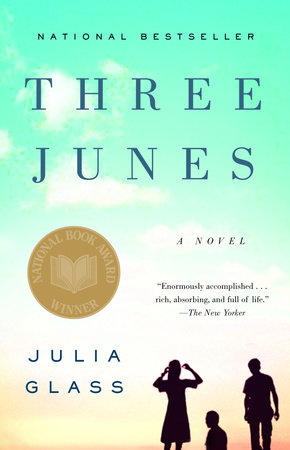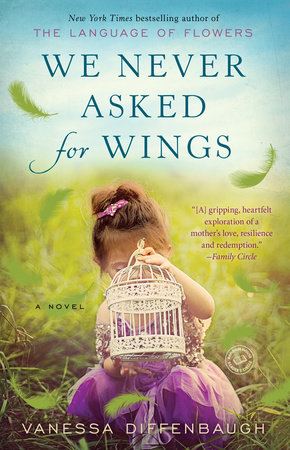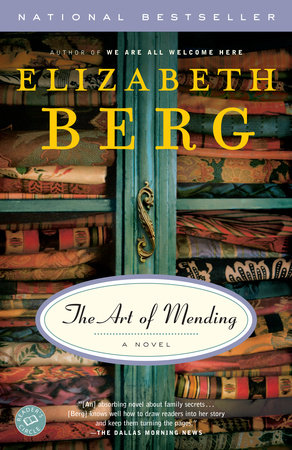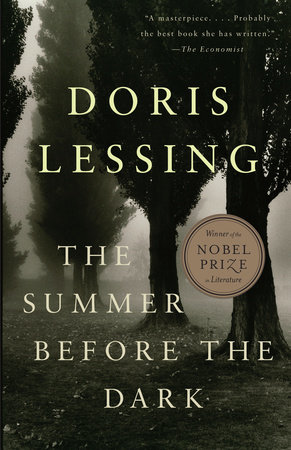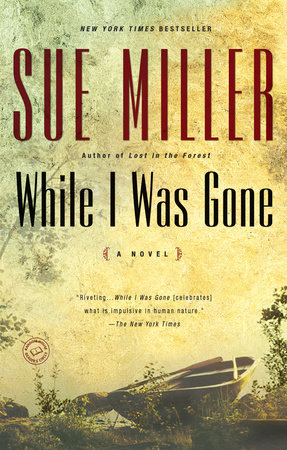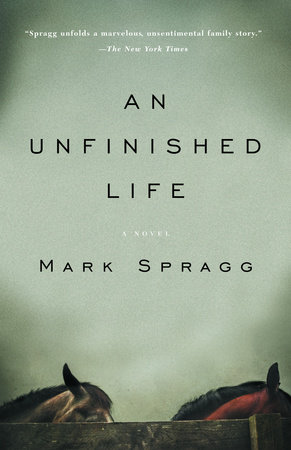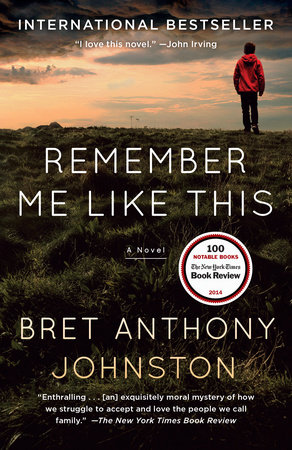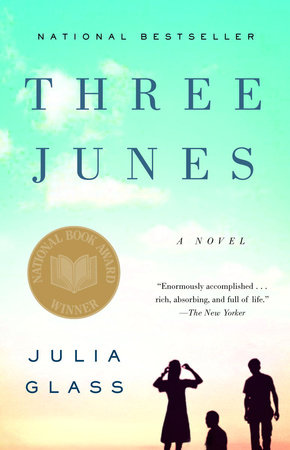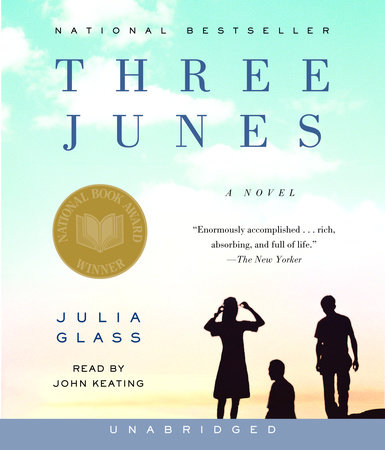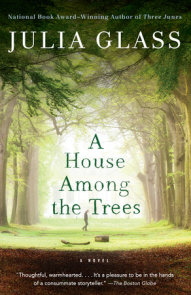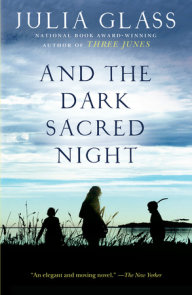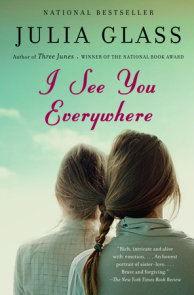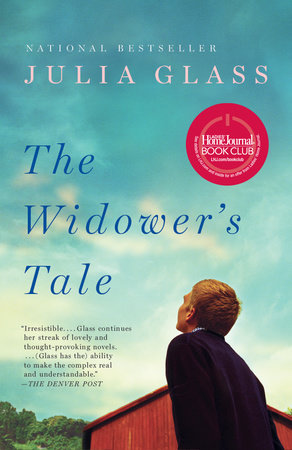Author Q&A
A Conversation with Julia Glass, author of Three Junes
Q: What led you to create Three Junes?
A: Sometimes it’s hard for me to think of this novel as something I created, because I never sat down and planned it out as a whole, the way you might cut and piece together a suit from a bolt of cloth (as I’d always imagined a novel gets written). Three Junes grew over several years, like a tree—organically and at first in odd, sporadic bursts—starting out as a short story called "Souvenirs," which was based on an experience I had while traveling in Greece after college. One of the first stories I wrote as an adult, it was your typical ingenue-abroad, loss-of-innocence tale with a predictably idyllic setting, and I was hoping to sell it to Cosmopolitan magazine, where I was working as a copy editor. (In those days, short stories—some by wonderful writers like Laurie Colwin, Lorrie Moore, and Elinor Lipman—were a fixture of the magazine. Often, there were two in a single issue, just as there once were in the New Yorker.) Reportedly, Helen Gurley Brown read my story but thought the heroine too "privileged" for her readers—that is, not your good old "mouseburger" COSMO Girl—so into a drawer it went. A few years later, I looked at the story again and decided that Paul, who had been little more than a third wheel or a foil, was much more interesting than Fern or Jack, and I decided to make the story his, not Fern’s. Suddenly, this character’s whole world seemed to crack open before my eyes—his dead wife, his waylaid ambitions, his country home, his sons—and I found myself with an ungainly narrative of 40 pages plus. I actually had the nerve to submit it to a couple of magazines and received a brief but kind rejection from the Atlantic the gist of which was "Sorry, though we’d love to see these characters inhabit a novel." Once again, into a drawer it went.
Somehow, though, what was now called "Collies" refused to be abandoned, and a couple years later, two things happened: First, I was intrigued by a fiction competition that included a category for "best novella" and decided to amplify the story yet further. Second, having by now published a couple of stories in modest venues, I’d been contacted by two agents who wondered if I had a novel. Somewhat stubbornly, I was writing only stories—you couldn’t really call them "short," since they were lengthy and complex, bursting at the seams like pregnant women refusing to buy maternity clothes—and when I wrote to a fellow writer how unfair it felt that these agents wouldn’t consider story collections, he wrote back something like "Stop complaining, get off your duff, and just write a novel. If you want to, you can." I was momentarily hurt, but I knew he was right. Sometimes I wonder if I would ever have written Three Junes without that kick in the pants.
Q: One of your characters states, “Everyone with a mouth and a memory has stories” (p. 39). But not everyone can write.… Were there stories in your own life, from your own memory, that inspired this book?
A: It is something of a constant surprise to me that Three Junes is almost wholly invented rather than autobiographical that is, in its plot lines since much of the short fiction I’ve written is based on events in my life or things I imagine about people I’ve met. It does draw extensively, however, on my general experience. Like Fern, I live in the West Village, and I spent a year in Paris on a grant to pursue my work as a painter, but I have never been widowed, the father of my children is nothing like Stavros, and I have certainly never been in a social situation like that weekend Fern spends on Long Island. Likewise, Scotland is a vivid, significant place to me, although I have visited the country only briefly, a few times in the ‘70s and ‘80s. My mother is quite proud of her Scottish roots and, through her genealogical research, made contact with relations there; I was sent over at age 17 as a sort of ambassador, and our families have stayed in touch ever since. While the McLeods are in no way based on my overseas cousins, I think that making Paul a Scotsman was an unconscious expression of my respect for family connections and traditions. Nothing in life fascinates or moves me more than families; no dramas are more compelling to me than the domestic.
The weaving of animals throughout the narrative is also a reflection of my experience, since I was brought up around dogs, horses, cats, and itinerant wildlife. Nor did I escape the influence of animals by moving to New York City; I ended up writing a magazine column on pets (my first published writing), and more than 10 years ago I volunteered for an organization that helps people with AIDS take care of their animals (often their closest companions). My job was to make “foster care” arrangements for dogs, so that if one of our clients had to go into the hospital without notice, someone would be ready and willing to take in his dog until he was discharged (or until, if he died, we were able to find someone to adopt it). Something that happened to me while doing that work stands like a shadow behind the seminal event at the core of the novel: the gift of a parrot to Fenno McLeod. When I went to interview one man about his dog, he told me he also had a parakeet but had just been told by his doctor that he had to give it up because of risks to his health. At the time, my sister was a vet up in Boston with a special interest in birds, and she found the parakeet a new home. When I went to pick the bird up from the owner, he looked significantly weaker than he had just two weeks before. He was in his pajamas, drinking tea from a delicate gilt-edged cup and saucer. As he sat there, looking so unbearably frail, drinking from that elegant cup, I had a heartbreaking glimpse of the life that was slipping away from him. While AIDS has spread horrifically on a worldwide basis, here in New York those years—the late ’80s and early ’90s—were the worst, the most hopeless, and I have never forgotten the contact I had, brief though it often was, with so many men who were fighting off death and in most cases losing.
Q: Anna explains to Fern, “When it comes to life, we spin our own yarn, and where we end up is really, in fact, where we always intended to be” (p. 298). Do you think you always intended to be a writer?
A: Yes and no. If you were to look in the book my mother kept about my childhood, you would see that I had yet to start school when I declared my intention to grow up and become “an author or an artist.” I was crazy for books—not surprising, since my father was working on his dissertation in pre-Columbian archaeology. Some of my first and sharpest memories are of the look and feel of the arcane, oddly illustrated volumes that filled the shelves in his study. But I also loved to make pictures, and through my school years I remained blithely faithful to both passions.
In high school, I wrote stories, poems, papers, journals, all with intense pleasure—but strangely, I think I began to take my writing ability for granted, perhaps because there were so many other flourishing student writers (many of whom are also professional writers today). When I went to college, I found myself more stimulated by my visual arts courses than my courses that involved writing. Meanwhile, I’m a little ashamed to say, I felt challenged by the macho, almost confrontational teaching style that seemed to have prevailed in that department from the days before coeducation. I thrived in this men-from-the-boys atmosphere, and in my final year, I was a scholar of the house in art: I had a private studio and worked only on my painting, rather than taking courses. The following year, I was awarded a fellowship to spend a year working on my own in Europe. Except for letters, writing was no longer a part of my life—and it took several years for me to miss it.
In my mid-twenties, like so many other fledgling artists, I moved to New York. For several years I lived alone (with a pet rabbit) and led a pretty austere life, working as a copy editor by day and painting by night. I was in a number of group shows but did not care much for the art “scene,” which was highly theatrical; how you looked and the society you kept seemed as important as the work you did. I read voraciously, as I always have, but my reading began to leave me with a kind of thirst. I realized that I was yearning to compose with words as much as with paint. Absurdly, I began to “sneak” time away from my artwork to write stories (I had not written fiction since high school). The problem was, I knew that having to make a living did not allow me the time to pursue both painting and fiction in a serious way. I decided to give myself over to writing for a while, and though it was a struggle, it felt like coming home. In the years since, I have painted off and on, but what I came to realize is that while I do have visual gifts—which, not incidentally, serve me well as a writer—I am at heart a verbal person, someone whose favorite toys are words. For me, making art is like speaking a foreign language fluently, but writing, language itself, is my native tongue, the one I know without even knowing how.
Q: Three Junes, teeming with its relationships and interconnected lives, resembles a wonderfully dense nineteenth-century novel in a way, despite its very modern characters and setting. Do you agree?
A: I am anything but a minimalist, and I don’t say this proudly, because if my work—visual as well as verbal—has one prominent weakness, it’s a tendency toward clutter. (I also have a tendency to talk too much and, I’m told by the one adult who lives with me, to fill a room with too many objects and too much pattern.) When it works, however—when it’s disciplined—the clutter can yield a magnificent richness, and that’s what I aspire to. If this makes me a Victorian of sorts, so be it.
I wouldn’t flatter Three Junes by comparing it with anything by Hardy or Eliot or Hawthorne, but they are all personal gods, so clearly I have such ambitions. In the years after college, when I had ample time to read whatever I wanted, I undertook to fill some of my literary gaps by going on reading binges of certain authors: E.M. Forster, Jane Austen, and George Eliot among them. One book I read then that impressed me above and beyond most of what I’d ever read—and it may have been partially responsible for my starting to write fiction—was Daniel Deronda. While I understand the criticism of its flaws, I was astonished by its characters and structure (not to mention its exquisite, masterly prose). Just the idea that you do not meet one of the two protagonists for over a hundred pages seemed revolutionary, and though I didn’t write Three Junes till many years later, I know that its ultimate structure was in some ways influenced by that impression. I’m not sure I could have risked what I did with Fenno’s character—making him the center of the novel yet keeping him largely offstage for most of the beginning and much of the end—without that example.
Q: Why did you divide the book into three parts with only the second as a first-person narrative? Why did you choose Fenno to set apart? In addition, why does Fenno occasionally address the reader, "Feeling left out, you will have noticed, is second nature to me" (p. 125)?
A: I mentioned earlier how essential character is to me in the creation of story; well, Fenno is a character who basically hijacked my soul as a writer. He’s the one who chose me. Working on Three Junes, I had an experience I’d never had before. In the past, my characters were largely composed in a deliberate manner—under my thumb, you might say—although they often seemed to make spontaneous choices that would surprise me. But Fenno (also Mal, and to some extent Paul) seemed to spring up from my psyche fully formed, like the goddess Athena from her father’s head. Writing in Fenno’s voice often felt like conversing with a stowaway, continuing the journey and letting go of anxieties about where in the world he came from.
One of the timeworn dictums laid down for first novelists is "Whatever you do, steer clear of the first person!" "Collies" had always felt completely natural in the third person, even though it was limited to Paul’s point of view, but when I started the second part of the novel, Fenno’s story, I couldn’t help hearing it in his own voice—and I was petrified. I knew I was embarking on the longest portion of the book and I thought, I can’t do this! Change time period, locale, point of view, and voice? Surely a big mistake. So I did try to work on the story in third person, and I lasted only a few pages. It felt like trying to bend steel pipe.
While writing "Boys," the third part, it hit me that what I was writing, structurally, was a triptych—that is, a strong central image flanked by two narrower, more modest images. I thought of the medieval Netherlandish altarpieces I love so much: Sometimes the central panel—be it a picture of the annunciation, the crucificion, or a martyrdom—is flanked by panels depicting portraits of the altarpiece donors (often husband and wife, male and female). While the central image is frontal, the donors are often shown in profile. And suddenly I had this very clear picture of Three Junes. Here was Fenno’s large, rich story at the center, told directly to the reader, with Paul and Fern portrayed in intimate detail to left and right but seen from the side and that’s what third person is: a kind of narrative profile view. From then on, Fern’s story flowed easily in the third person, mirroring Paul’s.
Q: Places figure crucially in the novel—for instance, a Greek island, a Scottish village, Greenwich Village, and a Long Island town. Are these places significant?
A: Certainly, all these places are places to which I’ve traveled (Paros and Dumfries, for example) or know intimately, as I do the Greenwich Village, my neighborhood for the past ten years. But beyond that, virtually all the locales of Three Junes, even Fern’s hometown, which figures only fleetingly, share an ideal quality. They are places popular with tourists or people escaping their everyday life. I made that choice intentionally, though it entailed certain risks, the first, quite simply, that places of such celebrity may upstage characters and events; the second, that they will make the story seem superficial or glib, like the escapist fiction you buy at the airport to distract yourself from the boredom and anxiety of flying. What I wanted, however, was to make place underscore the deep, nearly insatiable longing felt by the three major characters. Almost all these places are, in real life, places where we hope to receive some kind of sublime, intangible gift, be it beauty or peace or romance, and we often (though not always) come away unsatisfied. Greece, for instance—as the characters themselves acknowledge—is a place utterly steeped in the past. We go there as tourists to wander through ruins and marvel at the eerieness of time and mortality; perhaps we want the Oracle to make sense of our human lives. When he goes to Greece, Paul is torn between wanting to remain in his perfectly ordered past and to somehow get free of its grasp. He does receive a gift, but it’s not the one he expected. Scotland, as I mentioned before, brings to mind tradition and family loyalty (think of the clans and the tartans), but by the same token it is a place where acts of great barbarity and betrayal took place, where the land has been as tough and unyielding as it is beautiful. That, of course, is the duplicitous landscape of family itself: love and betrayal, war and peace. Paris, of course, represents true, everlasting love, while Amagansett is a place where we imagine people living perfect lives in perfect privacy…. And then there’s June, the perfect month: the month of blossoming, of weddings and conceptions, of—since our childhood—being freed from obligations.
Q: What is next for Julia Glass?
A: Before I was properly scolded into writing a novel, I was working exclusively on a series of stories about the lives of two very different sisters and their relationship as adults; I assumed that if I was lucky enough to publish a book, this would be it. I saw myself as concentrating on a specific though intense aspect of family—siblingship—and working my way up to writing a larger something (I hardly dared think “novel”) with a broader view of family. Well, now I’ve sort of done it backwards. But of course, there are endless variations on the theme, and I have continued to work on those stories. A few of them have won prizes and been published. I’ve also recently started a new novel about marriage, fidelity, and the drive to make other people happy. It’s called A Piece of Cake, and the main character is a pastry chef, a woman named Greenie Duquette. Unlike most protagonists I’ve created before, Greenie is happy—happy not just in her work but by nature. And she is a mother, also a new kind of heroine for me—motherhood being a relatively new experience in my life. My five-year-old was born not long before I conceived Three Junes, my one-year-old the week before my agent sold it.
